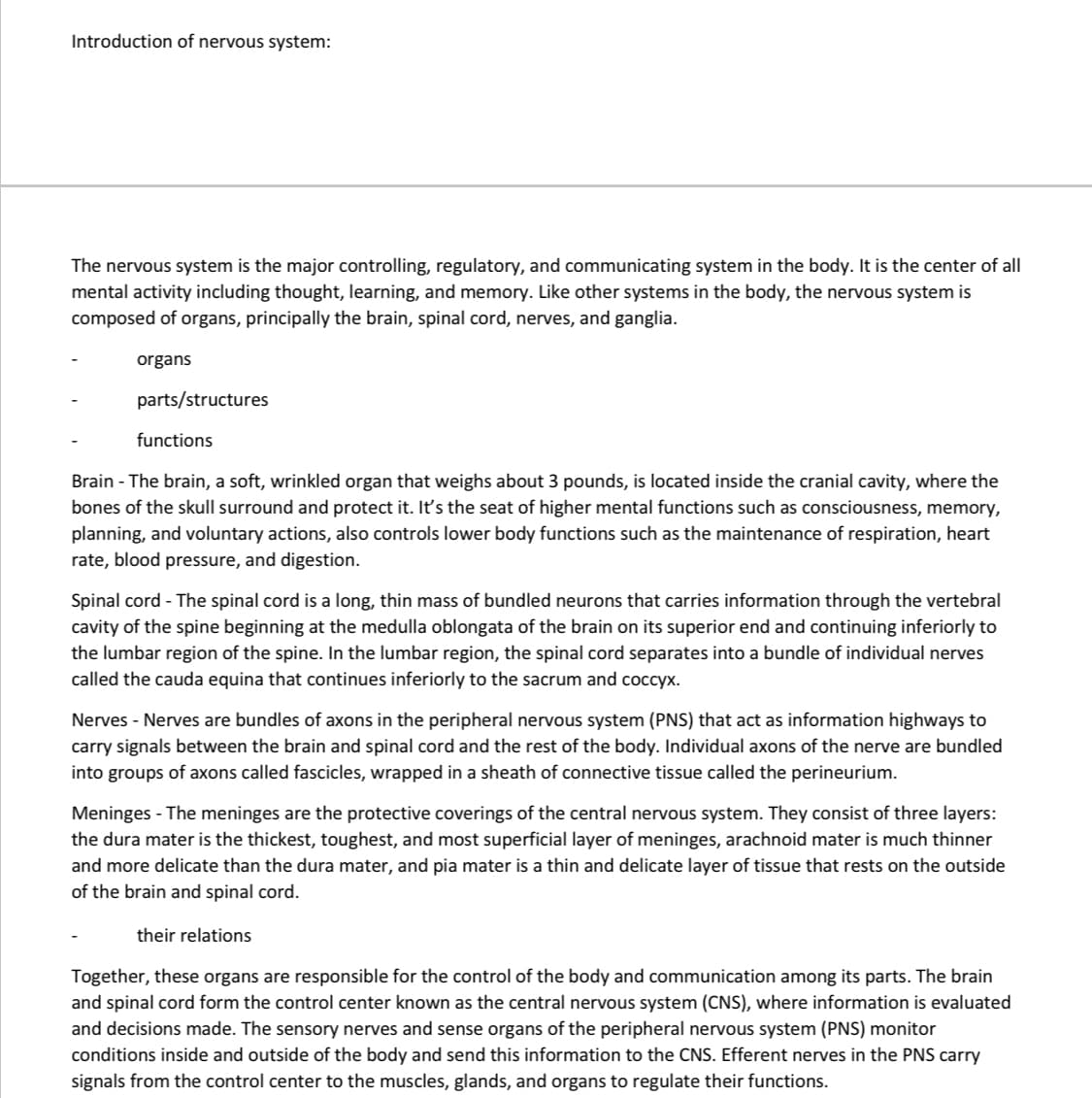The nervous system is the major controlling, regulatory, and communicating system in the body. It is the center of all mental activity including thought, learning, and memory. Like other systems in the body, the nervous system is composed of organs, principally the brain, spinal cord, nerves, and ganglia. organs parts/structures functions
The nervous system is the major controlling, regulatory, and communicating system in the body. It is the center of all mental activity including thought, learning, and memory. Like other systems in the body, the nervous system is composed of organs, principally the brain, spinal cord, nerves, and ganglia. organs parts/structures functions
Anatomy & Physiology
1st Edition
ISBN:9781938168130
Author:Kelly A. Young, James A. Wise, Peter DeSaix, Dean H. Kruse, Brandon Poe, Eddie Johnson, Jody E. Johnson, Oksana Korol, J. Gordon Betts, Mark Womble
Publisher:Kelly A. Young, James A. Wise, Peter DeSaix, Dean H. Kruse, Brandon Poe, Eddie Johnson, Jody E. Johnson, Oksana Korol, J. Gordon Betts, Mark Womble
Chapter13: Anatomy Of The Nervous System
Section: Chapter Questions
Problem 1ILQ: Watch this animation (http://openstaxcollege.org/l/braindevel) to examine the development of the...
Related questions
Question
Note: Explain and summarize the terms and ideas in the photo attached.

Transcribed Image Text:Introduction of nervous system:
The nervous system is the major controlling, regulatory, and communicating system in the body. It is the center of all
mental activity including thought, learning, and memory. Like other systems in the body, the nervous system is
composed of organs, principally the brain, spinal cord, nerves, and ganglia.
organs
parts/structures
functions
Brain - The brain, a soft, wrinkled organ that weighs about 3 pounds, is located inside the cranial cavity, where the
bones of the skull surround and protect it. It's the seat of higher mental functions such as consciousness, memory,
planning, and voluntary actions, also controls lower body functions such as the maintenance of respiration, heart
rate, blood pressure, and digestion.
Spinal cord - The spinal cord is a long, thin mass of bundled neurons that carries information through the vertebral
cavity of the spine beginning at the medulla oblongata of the brain on its superior end and continuing inferiorly to
the lumbar region of the spine. In the lumbar region, the spinal cord separates into a bundle of individual nerves
called the cauda equina that continues inferiorly to the sacrum and coccyx.
Nerves - Nerves are bundles of axons in the peripheral nervous system (PNS) that act as information highways to
carry signals between the brain and spinal cord and the rest of the body. Individual axons of the nerve are bundled
into groups of axons called fascicles, wrapped in a sheath of connective tissue called the perineurium.
Meninges - The meninges are the protective coverings of the central nervous system. They consist of three layers:
the dura mater is the thickest, toughest, and most superficial layer of meninges, arachnoid mater is much thinner
and more delicate than the dura mater, and pia mater is a thin and delicate layer of tissue that rests on the outside
of the brain and spinal cord.
their relations
Together, these organs are responsible for the control of the body and communication among its parts. The brain
and spinal cord form the control center known as the central nervous system (CNS), where information is evaluated
and decisions made. The sensory nerves and sense organs of the peripheral nervous system (PNS) monitor
conditions inside and outside of the body and send this information to the CNS. Efferent nerves in the PNS carry
signals from the control center to the muscles, glands, and organs to regulate their functions.
Expert Solution
This question has been solved!
Explore an expertly crafted, step-by-step solution for a thorough understanding of key concepts.
This is a popular solution!
Trending now
This is a popular solution!
Step by step
Solved in 4 steps

Knowledge Booster
Learn more about
Need a deep-dive on the concept behind this application? Look no further. Learn more about this topic, biology and related others by exploring similar questions and additional content below.Recommended textbooks for you

Anatomy & Physiology
Biology
ISBN:
9781938168130
Author:
Kelly A. Young, James A. Wise, Peter DeSaix, Dean H. Kruse, Brandon Poe, Eddie Johnson, Jody E. Johnson, Oksana Korol, J. Gordon Betts, Mark Womble
Publisher:
OpenStax College

Anatomy & Physiology
Biology
ISBN:
9781938168130
Author:
Kelly A. Young, James A. Wise, Peter DeSaix, Dean H. Kruse, Brandon Poe, Eddie Johnson, Jody E. Johnson, Oksana Korol, J. Gordon Betts, Mark Womble
Publisher:
OpenStax College